It’s time for a critical analysis of the “equality vs equity” meme, a widely duplicated and mutated image of three people standing on crates to watch a baseball game.
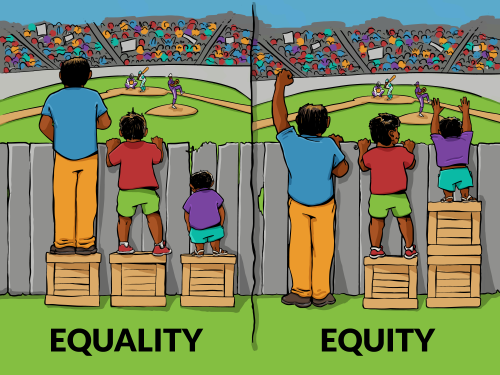
I shrink images to fit this blog’s margins. For bigger versions, see my sources. Source
The linguistic island
Of all my complaints about this meme, my most significant is about its choice of words. On the surface level, the meme is educating us about the distinction between “equality” and “equity”. However, outside of the meme, that is not how the words are used. The equality/equity distinction, mostly just comes from the meme. The meme is not educating us about the meaning of these two words, it is establishing new meanings.
It is not illegitimate to create new meanings for words, of course. But the problem is that the meme masquerades as educational, and everyone takes that for granted. As a result, every discussion of “equity” eventually comes back to the meme. The meme is a linguistic island, and there is nowhere else for the discussion to go.
Outside of the meme, “equality” and “equity” are used in broad ways across multiple disciplines, and are not normally given specific meanings that contrast with one another. This is easy to see by looking at Wikipedia’s disambiguation pages. Notably, in the context of political philosophy, there is a distinction between “equality of opportunity” and “equality of outcome”. These concepts, though they are both described as forms of “equality”, are strikingly similar to “equality” and “equity” from the meme. The similarity is not a coincidence.
One interesting fact I uncovered in my research, is that the original meme, created in 2012, did not use the term “equity” at all. The author of the meme, Craig, was trying to explain to someone why equal opportunity wasn’t enough, and that we also needed to consider equality of outcomes. The original text says “Equality to a conservative / to a liberal”. The author documents later changes to the meme. At various point, the two sides are labeled “equality”/“justice”, “equal”/“fair”, and finally “equality”/“equity”.
Now, higher education has taught me to be humble, and I acknowledge the possibility that in some preexisting context, “equity” has been contrasted with “equality”, as described in the meme. I did eventually find an educational research paper predating the meme that discusses the distinction. The abstract says “A survey of recent and earlier debates on ‘equity’ and ‘equality’ among scholars and researchers reveals disagreement and confusion about what those concepts really mean and what they involve in terms of goals and results.” The abstract goes on to propose distinct meanings for the two terms, which don’t sound exactly like what the meme says, but someone with journal access would need to verify. I suppose someone who was familiar with this literature might have added the word “equity” to the meme. But it seems nearly impossible to get from the meme back to wherever the distinction originally came from.
Suppose that we saw the meme–or got into an argument about the meme–and we wanted to learn more. We might google “equality equity”, and what would you find? It turns out there is only one context where the distinction between “equality” and “equity” is common, and that’s in educational materials. Usually, these articles explain what equity and equality are, almost always by referring back to the meme. I find this a bit circular–the meme educates us upon the words’ meanings, and those meanings only hold within the context of educating people about the words’ meanings.
The googling exercise also reveals another problem. See, one of the institutions that is most interested in educating people about the meaning of “equity”, are corporate Diversity, Equity, and Inclusion (DEI) institutions. These are the sort of organizations that provide diversity training to employees. That’s well and good, but you don’t have to be much of a cynic to realize that the underlying purpose of such organizations is to train employees on how to protect their employers from liability. I think we activists should by default be suspicious of the framings preferred by corporate DEI institutions. Such institutions are incentivized to promote simple narratives that reduce nuance and never rock the boat.
Analogy analysis
Although I complain about the meme’s choice of words, the main point of the meme isn’t really to define “equality” and “equity”. The point is to illustrate two approaches to a problem.
In particular, the meme is trying to explain the value of the second approach, the value of “equality of outcome”. In my experience, equality of outcome kind of has a poor reputation. Equality of outcome makes people think of “Harrison Bergeron”, where fit people must wear weights, beautiful people must wear masks, all in the name of bringing people down to an equal level. Or else they imagine redistributing wealth from the hard-working to the “lazy”. Given the poor branding of “equality of outcome”, perhaps it’s no surprise that later versions of the meme give it a different label. One could even argue the rebranding is necessary.
The meme depicts a situation where equality of outcome is the most intuitive and compelling solution, and equality of opportunity is nonsensical and unjust. “Opportunity” is represented by the number of crates each kid stands on. “Outcome” is represented by the elevation of their head, and in particular, whether they can see over the fence. Equality of outcome is clearly the best approach, satisfying all three persons’ objectives to see over the fence.
I’ve written a lot about the failure modes of arguments by analogy, but this analogy is pretty good? If anything, this analogy veers into “too effective” territory; the analogy works because it causes us to import certain assumptions that hold in the baseball situation, but which do not hold universally. For example:
- The only objective is to see over the fence, and there is no advantage to being able to see any higher. This implies that if we find a solution where everyone can see over the fence, it is a dominant solution–no other solution leads to an improvement for any individual.
- There are a fixed number of crates, enough for everyone to see over the fence if distributed properly. We never deal with the variant where there’s only one crate, and the dominant solution is to give it to the person in the middle, even though that isn’t equal or equitable in any sense.
- The analogy uses height to represent each person’s capabilities, and height is commonly accepted to be innate, unchangeable, and not subject to moral scrutiny. Now the libertarian argument is that people’s capabilities are self-determined, and that equal outcomes undercut the incentives that make people strive to do better; so the libertarian would conclude that height is not an appropriate analogy. I think the libertarian argument is incorrect in most situations, and height is an apt analogy for many situations. But as far as the meme goes, it doesn’t really do anything to counter the libertarian argument, it just sidesteps the issue.
- The meme leaves out issues of who decides the distribution, and generally just doesn’t question the situation that the people are placed in. This is addressed by many mutations of the meme, which I’ll discuss later.
The analogy successfully demonstrates how equality of outcome can be a useful principle in at least some situations. However, it does not demonstrate that equality of outcome is always the correct principle. There are plenty of situations where even liberals would agree that equality of outcome is incorrect.
For example, most people don’t believe that all movies should be equally successful. Movies are disanalogous to the meme, because while the movie studios may prefer to make a return on each investment, it’s not a societal good for them to do so. In contrast, I would want employees of the movie industry to get paid equally well regardless of the movie’s success, because it’s not like they control how good the movie is, and they need to eat, etc.
And how would the analogy work in a real political dispute, such as affirmative action? Affirmative action isn’t exactly equality of outcome, because some students are admitted and some are not, and most people agree that academic performance should be a factor in that decision. I don’t think removing affirmative action would necessarily lead to equality of opportunity, since racism undercuts the opportunities of underrepresented minorities before they even get to university, and since universities would likely still use class-based affirmative action. I’m beginning to think that there are more than just two kinds of equality and that the analogy simply doesn’t equip us to deal with the complexities of affirmative action.
Of course, it’s just a meme, and we can only expect so much out of it. Perhaps this is why DEI institutions like it–it demonstrates one small point and then gets out of the way before getting too political.
Memetic mutations
One consequence of the equality vs equity meme being so wholeheartedly adopted by corporate DEI institutions, is that many many of them have decided to make their own version of the meme, often translating it into the flat corporate aesthetic.
This is the sort of thing I’m talking about.
I find it funny that many of these variants have an unequal number of crates on the left and right. The original meme works because intuitively there’s no advantage to being at higher elevation as long as you can see over the fence; thus by redistributing the crates, nobody really loses. But I’m sure DEI instructors have gotten into arguments during training sessions, about how the tallest person obviously loses out in the “equity” solution. So they deflect the argument by depicting everyone as strictly better off under “equity”. Redistribution is apparently too radical, more crates for everyone.
But if the complaint is that the meme doesn’t rock the boat enough, there are plenty of variants that try to say something more, often by depicting a third option. One particularly common variant removes the fence, and calls it “justice” or “liberation”.
This of course raises the question of what purpose the fence ever served. Perhaps to protect spectators? Maybe removing that barrier is a bad idea? So then other variants replace the wooden fence with a chain link fence. Of course, this presumes the resources to put up a chain link fence. And you know what, there’s a whole stadium in the background, of course they have the resources for a chain link fence! Come to think of it, how come nobody ever thinks to depict the solution we use in the real world, i.e. stadium seating or bleachers?
Then there are right-wing/libertarian variants of the meme, like the one portraying capitalism.
That one is pretty funny because why would you even want to stand on top of a mountain of crates—what, to see the game better? Somewhere in there, there’s a Marxist analysis about the fetishization of money. And just like I said for the corporate variants: redistribution is apparently too radical, more crates for everyone.
And then there’s the version where “equity” is depicted as cutting off the legs of the taller people (image not included here). A bit melodramatic, if you ask me. That variant of the meme definitely communicates a vision of the world, but doesn’t do anything to persuade us that the vision is accurate.
There’s another criticism from the left*, which says that height is a poor analogy because it’s innate, whereas the challenges faced by underrepresented ethnic minorities are imposed by society. This critique motivates variations of the meme where instead of having people of different heights, the ground is sloped.
*The original article is down, but you can find copies of it on internet archive.
Height may be a better analogy for disability accommodations than for race. I think the problem is that you just can’t have one meme that’s applicable to all situations.
Finally, there’s another version of the meme appears to borrow imagery from Shel Silverstein’s “The Giving Tree”. It combines a lot of the patterns I’ve discussed above.
The internal logic of this version doesn’t really make any sense. How is this magical straightening the tree supposed to work? How do we coerce the tree into growing apples evenly? I don’t know stuff about trees, is that a thing that we can do with trees? Isn’t the more sensible solution to just have both kids picking from the same side? Or if we can pool our resources to magically straighten the tree, couldn’t we just use those resources to pick all the apples, and hand them out in a basket? I don’t even know. The original meme was compelling in a way that this one is not. On the other hand, an apple is a more relatable macguffin than watching baseball.
Conclusion
The equality vs equity meme is a simple illustration of the difference between equality of opportunity and equality of outcome. It’s a compelling demonstration of why equality of outcome, despite its poor reputation, is the most sensible approach in some situations.
However, it also rebrands these two kinds of equality as “equality” and “equity”. This causes the meme to be linguistically isolated from any external discussion of these concepts, and if you ever search these two terms, you loop right back to the meme again. The meme may be a good starting point, but it forces itself to also be an ending point; and it’s not a good ending point.
Locked in this dead end of a meme, lots of people have made endless variants, trying to express their ideas through the lens of the same meme, even when it doesn’t make sense. And corporate DEI institutions, for their part, have embraced the meme–for them, its limitations are a plus.
I’m not a sloganeer, I’m an analyst. The purpose of a slogan or meme is not to be 100% accurate and immune to criticism, they’re just supposed to demonstrate basic points and emotionally resonate with people. So, even good slogans and memes can be picked apart. I am not really a fan of the meme, but picking it apart doesn’t mean it’s bad. Rather, this is my way of addressing what I see as the meme’s biggest problem. The meme is a dead end, but through critical analysis we can find a way out.

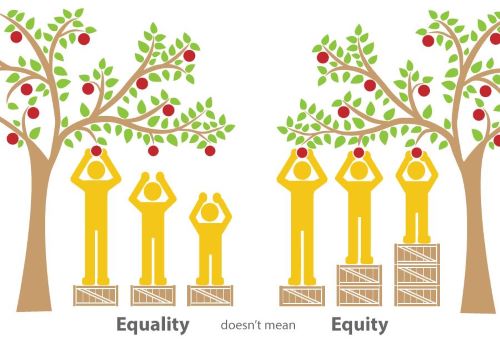
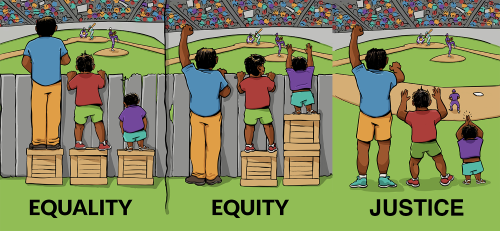
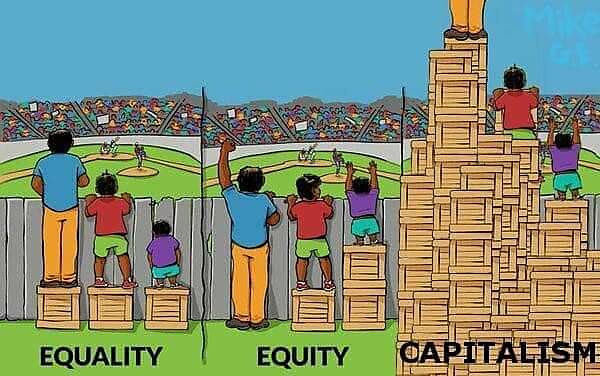

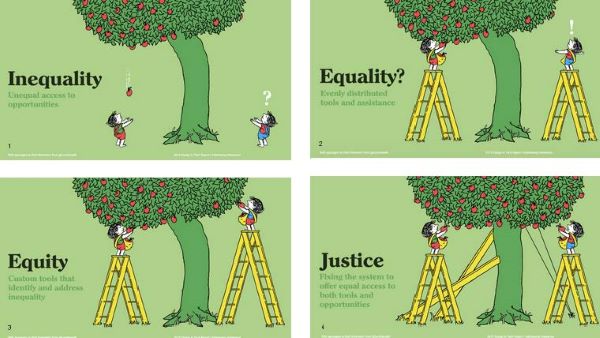
You’re right — like you, I came across this meme during some corporate training, and it bothered me a bit, but I brushed those concerns aside. But you’ve got me thinking about them again.
For instance, how does the meme apply to the field of education? Much of the way education works in the last decade or so seems to be predicated on the idea that it’s like helping people see over a fence. First you construct the fence itself, in the form of a standardized test that everyone has to pass. Then, of course, the bright students can pass the test easily, so you can afford to ignore them. Instead, all of the money and resources should be spent on the students who have difficulty passing the test — that’s certainly what the meme seems to suggest.
An alternative model for education might come from an activity like weight lifting. The goal of weight lifting isn’t actually to get a heavy weight off the ground — if it was, a weak person could accomplish it with the help of a fork lift. Instead, the purpose of weight lifting is to give everyone an appropriate challenge so everyone becomes stronger. Applied to education, it would suggest a model where everyone is offered challenges appropriate to their strengths and weaknesses.
One other thing — Vonnegut wrote a bunch of great stuff, but “Harrison Bergeron” kind of sets me off. It’s often used as a slam against equality of outcome, as you say. Except that effective satire takes an existing tendency and exaggerates it — and pretty much nobody is actually advocating that we should handicap the able in order to give a competitive advantage to the challenged.
Regarding the “Capitalism” variant of the meme, if it really is right-wing/libertarian (as opposed to some parody) then it’s not just comically unappealing — it’s a goddamn lie. It says that a rising pile lifts all spectators, not true at all, under capitalism.
xrist that right wing version is such assholery. while people are catching black mold from their melting slums and dying from easily prevented conditions how in the shit can you be so evil as to suggest they can see over the fence? i’m sick to death of those fucks.
brucegee1962: Actually in education, in the era of testing, most of the money goes into helping those who are just below passing level, as this gets the most ROI – biggest improvement in passing rates for the smallest sum of money (so just the situation where there is just one crate and it is given to the middle-height person). The ones who can pass without help will manage, but probably not get as much out of their education as they could have, and those really to far behind are left with no hope whatsoever.
I am a political philosopher and I am writing a book on equality. I basically agreed with you about this meme, but one could interpret it as fitting with a certain way of understanding equality versus the kind of equality demanded of justice. There’s (at least) formal equality, moral equality, and substantive equality (the most prominent version until very briefly was distributive equality, specifically). So, if we focus just on moral equality and substantive equality there’s a useful distinction first made by Aristotle. He said numerical equality (giving people the same) is different from proportional equality (giving them their due according to some theory of justice or another). Jump forward 2.5k and Ronald Dworkin (reading Rawls) says there’s equal treatment and separately equal concern and respect. Again, think of one as treating everyone the same versus treating everyone in the way appropriate according to the right theory of justice. If you think people are morally equal, then you think they deserve equal concern and respect but what constitutes equal concern is unlikely to be strict equality. So, a different way of reading the meme. It’s numerical/equal treatment versus proportional/equal concern and respect.
My beef with the meme is that the word “equity” isn’t a theory. Equality of opportunity is a theory. That the least well off should be as well-off as possible or that everyone should have sufficient means to live a reasonable life are theories. Just writing the “equity” under a picture of people watching a baseball game standing on various sized boxes is not a theory. I think the most generous reading is that, without saying exactly what it is, they are gesturing to the idea that a theory of justice is unlikely to just be a call for simple equality of resources. The larger lesson, in my not exactly the received view, is that equality doesn’t always imply equal. (It’s 3:30 in the morning and I am taking a break from a 6 hour writing jag. Please, excuse the errors this is no doubt riddled with.)
What about equality of access? Everyone having access to a home a job healthcare education. Equal opportunity and equity sustain the status quo and bestow advantage’s.